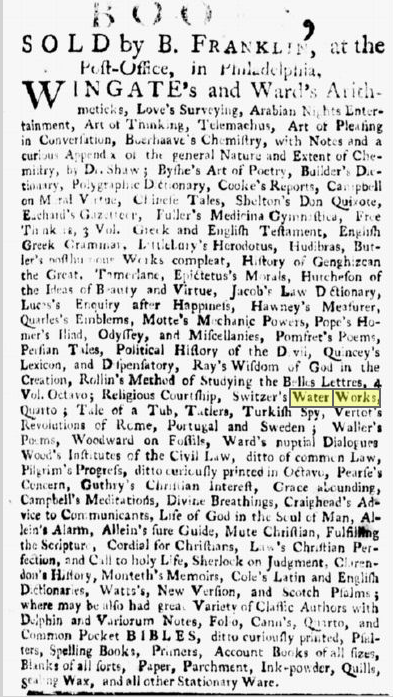
| Introduction | Historical Background | Chronology | Geography | Biography | Technology | Ownership and Financing | General Bibliography |
Builders of early American water-works drew on a wide range of European experience, including the writings of the Roman architect Vitruvius and accounts of archeological discoveries of Roman water-works in England and elsewhere. Historical accounts of early London water-works were also known as well as the Parisian water-works projects in the 1780s.
Many other early water-works had existed, but did not become widely known until they appeared in scholarly works in the late 19th and early 20th Centuries, which are included in the general bibliography section.
Two American communities had water works built in the 17th Century, Boston in 1649 and Albany in 1678. These were both built by English settlers, who could have drawn on a wide experience from aqueducts in that country, including systems in London, Portsmouth, and Exeter.
Another twelve communities built or anticipated aqueducts before the Declaration of Independence was adopted in July, 1776, and one system was built during the Revolutionary War in Salem, North Carolina, as shown in the following table:
| Year | City | State | Comments |
| 1720 | San Antonio | TX | Built by Spanish Missionaries. |
| 1744 | Schaefferstown | PA | Built by William Schaeffer from Germany. |
| 1753 | Winchester | VA | A 1753 deed from Thomas Fairfax to James Wood required Wood and his heirs to provide water conveyed in pipes to the town. |
| 1754 | Pittsfield | MA | Built by local resident Charles
Goodrich. |
| 1754 | Bethlehem | PA | Built by Moravian immigrants. |
| 1772 | Lancaster | PA | Built by local resident Casper Singer. |
| 1772 | Providence | RI | Two systems built by corporations. |
| 1773 | Nazareth | PA | Built by Moravians from Bethlehem. |
| 1773 | East Greenwich | RI | System built by corporation. |
| 1774 | San Antonio de Padua | CA | Built by Franciscan Missionaries |
| 1774 | Dover | NH | Petition submitted by Cyrus Bangs. |
| 1775 | New York City | NY | Built by Christopher Colles, who
immigrated from Ireland in 1771. |
| 1778 | Salem | NC | Another Moravian settlement, influenced
by the system in Bethlehem. |
Immigrants from continental Europe would have had their own history of water works to draw upon, while a body of water works literature in began to appear in the early 18th Century that would have been useful to developers of American water works.
1704 Apopiroscopy A reissue. Art's Improvement: or, Choice experiments and observations in building, husbandry, gardening ... Extracted from the most celebrated authors ... by T. S. By Richard Neve
1734 An universal system of water and water-works philosophical and practical. In four books. Faithfully digested, from the most approv'd writers on this subject, by Stephen Switzer. ... In two volumes. This is listed for sale in 1742 by Benjamin Franklin in Philadelphia (see advertisement below).
1736 Neve's The city and country purchaser and builder's dictionary, by Richard Neve
1739 Architecture Hydraulique, Ou L'Art De Conduire, D'Elever, Et De Menager Les Eaux, Volumes 1-2, Bernard Forest de Bélidor | Volume 1 | Volume 2 |
1728 The
Boston Gazette, January 22-29, 1728
Madrid, October 14. A few Days since died at Toledo, an English Man
names Jones, who had been contracted with for conveying Water thro' Pipes
of a large Bore, into that City from Springs at a considerable
Distance. 'Tis thought he died of Grief, occasioned by the Spaniards
breaking their Contract. The Priests give out that he died a good
Catholick. He was well known in England by the Name of Gun Jones.
1835 Hydraulia, an Historical and Descriptive Account of the Water Works of London: And the Contrivances for Supplying Other Great Cities, in Different Ages and Countries, by William Matthews
 |
| Pennsylvania Gazette, August 17, 1742, Page 3 |
1855 Salem Register,
October 29, 1855, Page 1.
'Hobson's Choice.' The old conduit at Cambridge, which will not be
superseded by the new one about to be erected in that city, (which we hope
it will be elsewhere preserved,) was built in 1614, from funds supplied by
the celebrated Thomas Hobson, the carrier, whose stringency in letting his
horses for hire, only each one in his proper turn, regardless of the whims
or likings of his customers, gave rise to the well known proverb,
'Hobson's choice - that for none.' He appears to have been a wealthy
and respected citizen, not content with merely raising the edifice, he
left by will the sum of £10 for further beautifying it, with an estate,
the annual proceeds of which have been ever since available for its
maintenance. Thomas Hobson died on the 1st of January, 1630.- The
London Builder.
1899 The Two Books on the Water Supply of the City of Rome of Sextus Julius Frontinus: Water Commissioner of the City of Rome A.D. 97: a Photographic Reproduction of the Sole Original Latin Manuscript, and Its Reprint in Latin; Also a Translation Into English, and Explanatory Chapters, by Sextus Julius Frontinus, with translation and explanatory chapters by Clemens Hershel.
1996 "The hydraulics revolution: Science and technical design of urban water supply in the enlightenment," by Edward Howard Winant, PhD Dissertation in History, West Virginia University
2001 Water Technology in the Middle Ages, by Roberta J. Magnuson
2017 A Tale of Three Thirsty Cities: The Innovative Water Supply Systems of Toledo, London and Paris in the Second Half of the Sixteenth Century, by Chaim C. Shulman
2017 The History of the London Water Industry, 1580–1820, by Leslie Tomory
© 2016 Morris A. Pierce